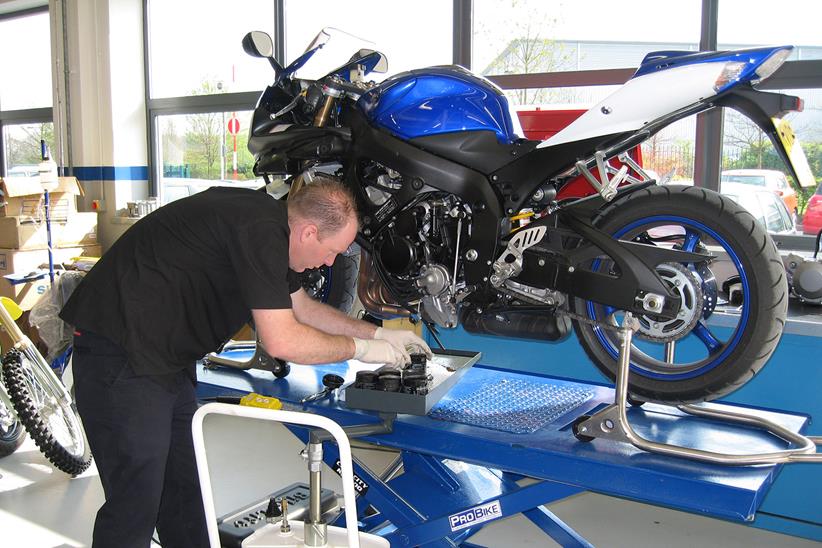How to sharpen your throttle response
It jerks. It snatches. It’s a slug. If your throttle response leaves something to be desired, we’re here to help
1. Before you start
Make sure the basics are right: engine properly serviced, no air leaks (or recent alterations) in the inlet or exhaust systems. Now you can define the problem. Starting with carb’d bikes, it’s fairly simple. An engine running lean at low rpm tends to feel snatchy and unpleasant. It’ll also need lots of choke and take a while to warm up. If it’s too rich it feels slow and fluffy, as if it can’t be bothered to rev, or for the revs to die back down again. If the mixture is just right it feels alive and eager.
![]()
2. Brit carbs
Old Brits usually run Amal carbs whose soft alloy wears out with monotonous regularity: the slide and bore rub against each other with no lubrication, opening up the snug fit they had as new. The resulting bagginess leads to a richer mixture, spoiling the bike’s low-speed fuelling precision. Owners’ clubs recommend specialists who can restore the slide-to-bore fit, often to better-than-new spec. Shops such as P&M Motorcycles in Brentford or Allen’s Performance can also supply greatly superior Mikuni or Keihin carbs to suit British bikes. If you’re a money-no-object non-purist they’re excellent.
![]()
3. Japanese carbs
Japanese original equipment carbs are far more sophisticated than British bikes’ Amals, and harder-wearing, so typically it’s wear on the needles and emulsion tubes that you notice first. The consequence is rich running: the engine feels woolly and laboured until about half revs. The big challenge is that finding replacement parts is difficult (Amal and Dell’Orto, by contrast, and aftermarket Japanese carbs, have superb spares back-up). If your inline four feels sluggish and you want it to stay standard, find another set of carbs and hope they’re less worn than yours, otherwise go aftermarket.
![]()
4. Laid-up disease
For the past decade, pump petrol has been mixed with small quantities of ethanol, with dire consequences for infrequently-ridden bikes. Ethanol likes water so much it absorbs it from the atmosphere. This moisture then gets to work on metal fuel tanks and brass jets in carbs, literally nibbling the metal away. Since jets are very fine metering devices, even a small change in their dimensions can create rich running in a bike that’s been laid up for a long while. Symptoms are dismal fuel consumption and throttle response, and a smell of petrol which anyone riding behind you will let you know about.
![]()
5. When only a dyno will do
There are other ways to sort out poor carburation or fuel injection, but time spent on a dynamometer is the best. It’s essentially a big roller which provides a known resistance to your back wheel’s turning force, combined with a sniffer up the exhaust which can tell whether your mixture strength is too rich, too lean or just right. Thus your mechanic can replicate on-road conditions, and adjust fuel delivery accordingly. Like all tools, a dyno needs a skilful, experienced operator – not someone who started up last week, so choose your specialist carefully.
![]()
6. Injected bikes
Typical annoyances are: a) going from open to shut with an undignified jolt; b) darting forward momentarily as you blip your downchanges on the entry to a corner; c) surging and fading on the motorway; d) an inability to hold a steady 30mph. All this can occur with a brand new, standard bike. Why? Because factories have to balance giving you good throttle response with the need to keep the exhaust gases clean. Good response comes from chucking plenty of fuel into the engine. Good emissions come from keeping the fuel supply to a minimum. Hence the increasing complexity: ride-by-wire throttles, catalytic converter protection loops, and dozens of fuel maps which alter ignition and fuelling depending on gears, temperature and more.
![]()
7. Power Commander
Some weak-running early Noughties machines just felt a bit snatchy as the throttle opened. The easiest solution was to bolt on a device which intercepted the ECU signal to the injectors, and added or subtracted fuel as instructed. This was the Power Commander. You can still use them now, and they’re often a good option on earlier injected bikes (say, up to 2006). They’re also easy to remove and sell on if you change bikes. But for later, more complicated motorcycles like the ones on sale today they are limited in how much fine detail they can handle.
![]()
8. Remapping
This time the dyno operator gets into the ECU and rewrites its instructions. Unlike a Power Commander this method gives control over: fuelling, ignition timing, rev limits, maps for different gears, exhaust flaps, you name it. The snag is that this will only make your bike feel nicer if the dyno operator has taken the time to understand how your ECU works. And that’s a matter of experience. It’s also vital to ensure you have a back-to-standard option. Just in case. There are people on the internet who will offer you software and cabling to fiddle with your bike’s ECU. Don’t even think about it.


